SEO
How to Find Quality Backlinks for Your Website
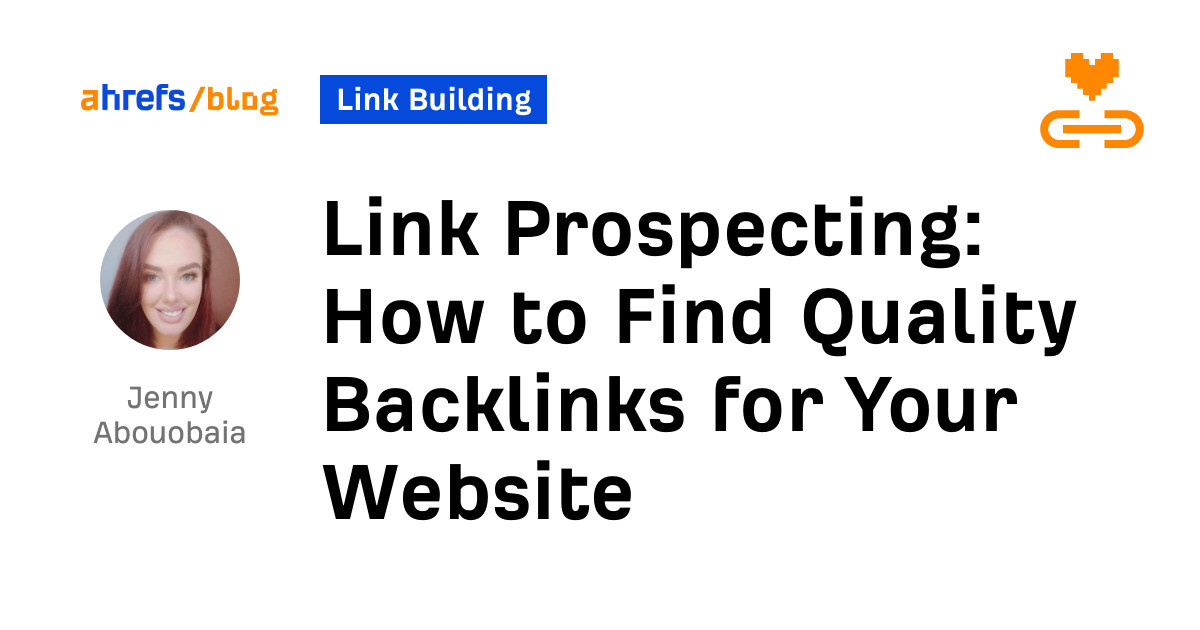
We all know that link building is a crucial part of any SEO campaign. But to be successful, it is all about quality over quantity.
This is where the process of link prospecting comes in. Finding and evaluating the quality of a potential site is essential for link building success. In this article, we will look at how to do link prospecting in five easy steps.
Link prospecting is the process of finding and evaluating potential sites to acquire links from.
This means identifying potential sites depending on the type of link building strategy you are using, checking the quality of that site, and finding the appropriate people to reach out to as part of your outreach campaign.
Link prospecting is the essential first step to building a solid link strategy. Without it, every other aspect will likely fall to pieces.
Link prospecting helps you identify sites to acquire links from and, more importantly, helps you identify sites to avoid.
With Google making it a priority to “neutralize the impact of unnatural links on search results,” the last thing you want is to intentionally attract any kind of link spam to your site.
Of course, every website can naturally pick up some spam links. Coupon sites and auto-generated blogs are just some undesirable sites that can link to yours.
However, link prospecting allows you to ensure every link you build is intentional and adds value, improving your site’s relevance and authority in the eyes of search engines.
Now we know what link prospecting is and why it is important, we need to know how to actually do it. There are five key steps to link prospecting, so let’s take a look at those in more detail.
Step 1. Consider your link building strategy
The types of link prospects you need to acquire and the methods you use to find them will heavily depend on the tactics you intend to use.
The best link acquisition tactics to use include:
It’s important to establish a clear strategy regarding which tactic you will use. If you are going to use multiple tactics, you will need certain prospects for each type of campaign you intend to do.
For example, if you want to try guest blogging, you need to identify relevant sites in your niche that meet your evaluation criteria and are open to publishing content from guest authors.
Whereas if you want to run a skyscraper campaign, this will involve analyses of your competitors.
Step 2. Identify your evaluation criteria
You also need to establish your evaluation criteria. What makes this site a good prospect? There are certain metrics that are good for weeding out potentially poor prospects, including:
Relevance: This will depend on your business, goals, and your link building efforts. There are two types of relevance: topical and geographical.
If you want to acquire links to build perceived authority with search engines, you will need links from a site with high topical relevance.
Whereas, if you are looking to improve your local SEO and get business from local customers, you will want to build geographically relevant links from sites like other local businesses or news outlets, for example.
Domain Rating: The DR of a website is a good indicator of how strong its backlink profile is, as well as how much link equity can be passed to your site.
Organic traffic: How much organic traffic a website gets each month can indicate the quality of the site and that the backlink profile has not been manipulated in any way. For example, a site might have a super high DR with zero traffic, which would be one to avoid.
You can check these metrics of any site by plugging it into Ahrefs’ Site Explorer to get a quick overview.
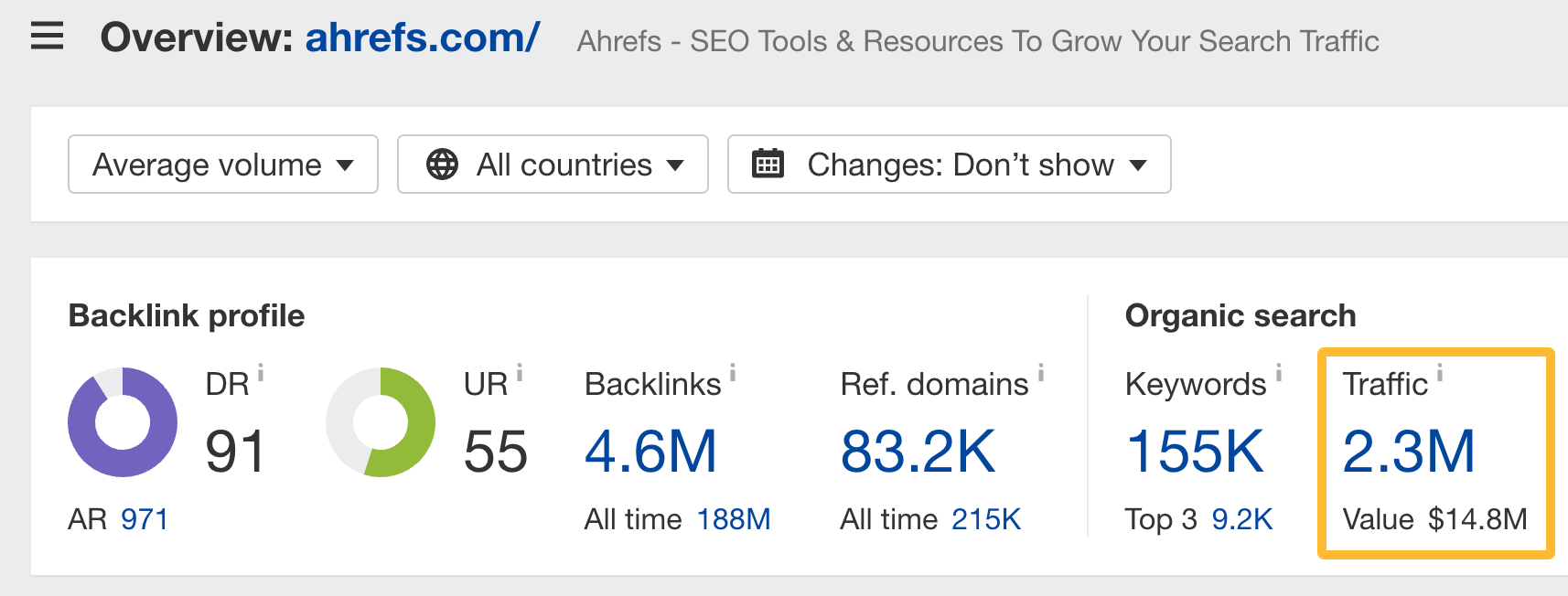
Step 3. Find relevant and high-quality link prospects
Now that you have a clear link building strategy and evaluation criteria, it’s time to start finding relevant and high-quality link prospects.
You can use several different methods to do this, and we will look at my four favorite ones in more detail.
Finding prospects through competitor analysis
Using competitor analysis is one of the quickest ways to find quality link prospects.
Why? Assuming your competitors have already evaluated the quality of these sites, the qualification process is likely to be much faster. And since those sites have already linked to your competitors, there is a probability that they will link to yours too.
Are your competitors mainly guest blogging? Using niche edits or HARO link building? These insights can help you replicate your competitors’ link building efforts and even the playing field on the search engine results pages (SERPs).
You can check out your competitors’ links in a couple of different ways.
You can start by identifying your competitors with the Organic competitors report in Site Explorer.
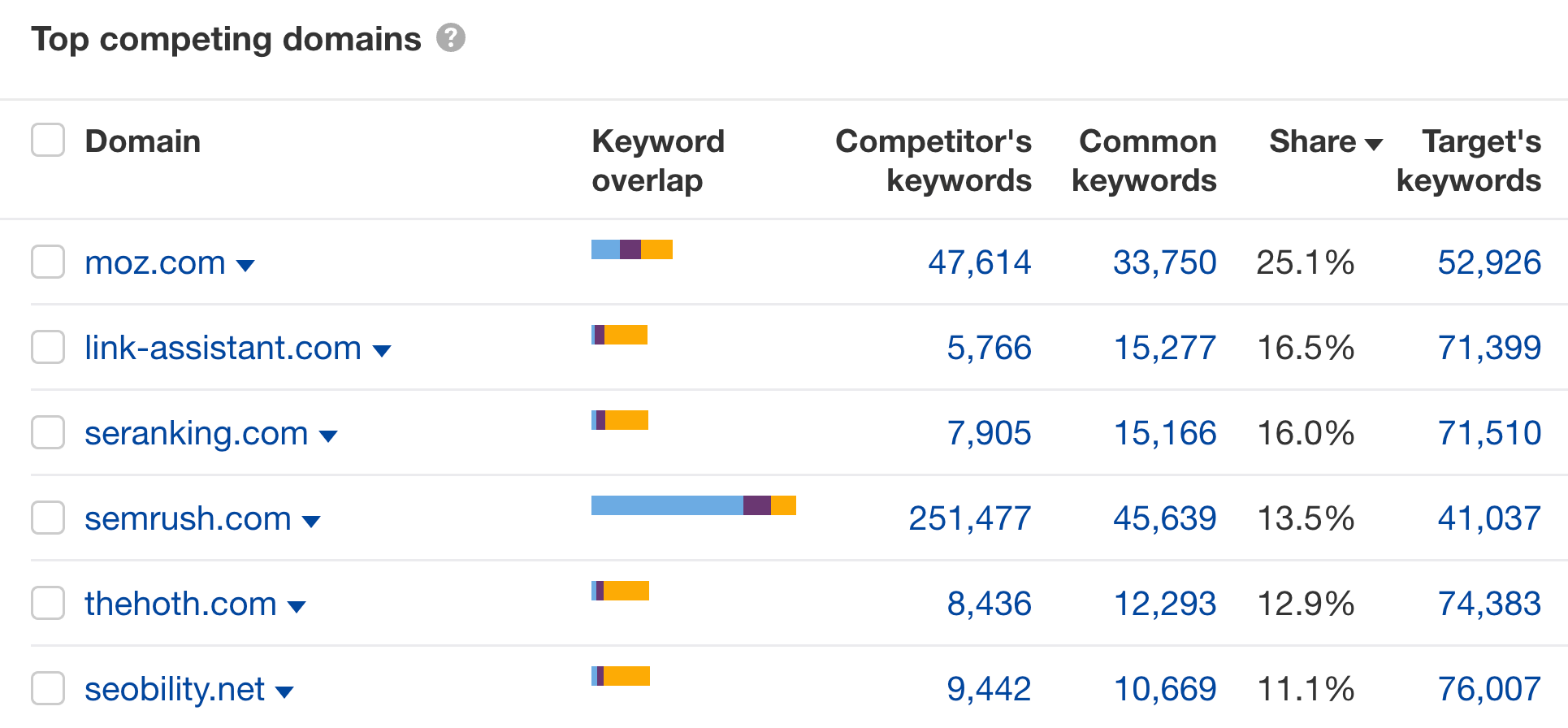
Next, select your most important competitors and use the “Open in Link Intersect” option.
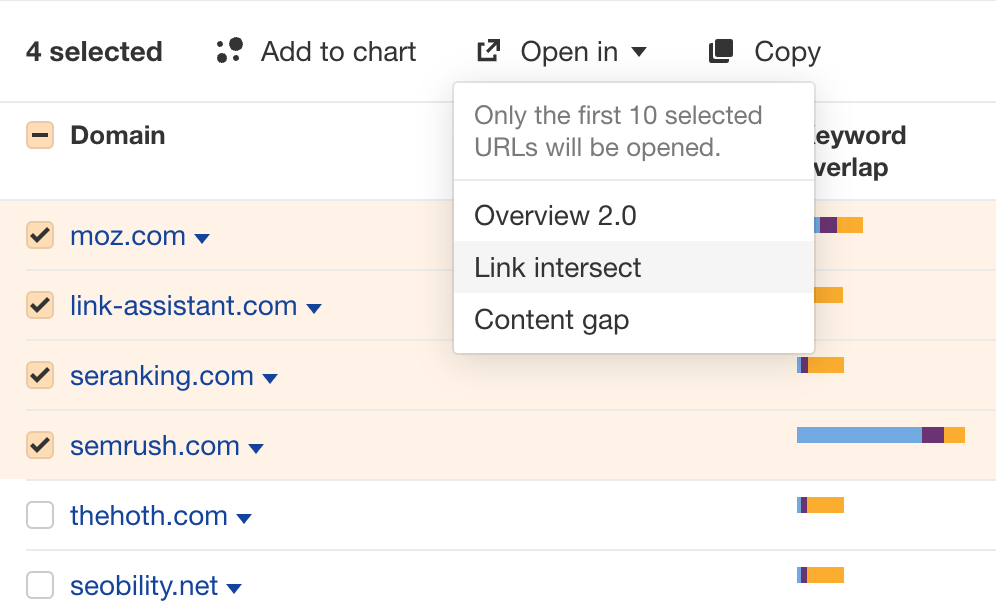
This will give you all of the referring domains your competitors have and show how many different competitors have links from those sites.
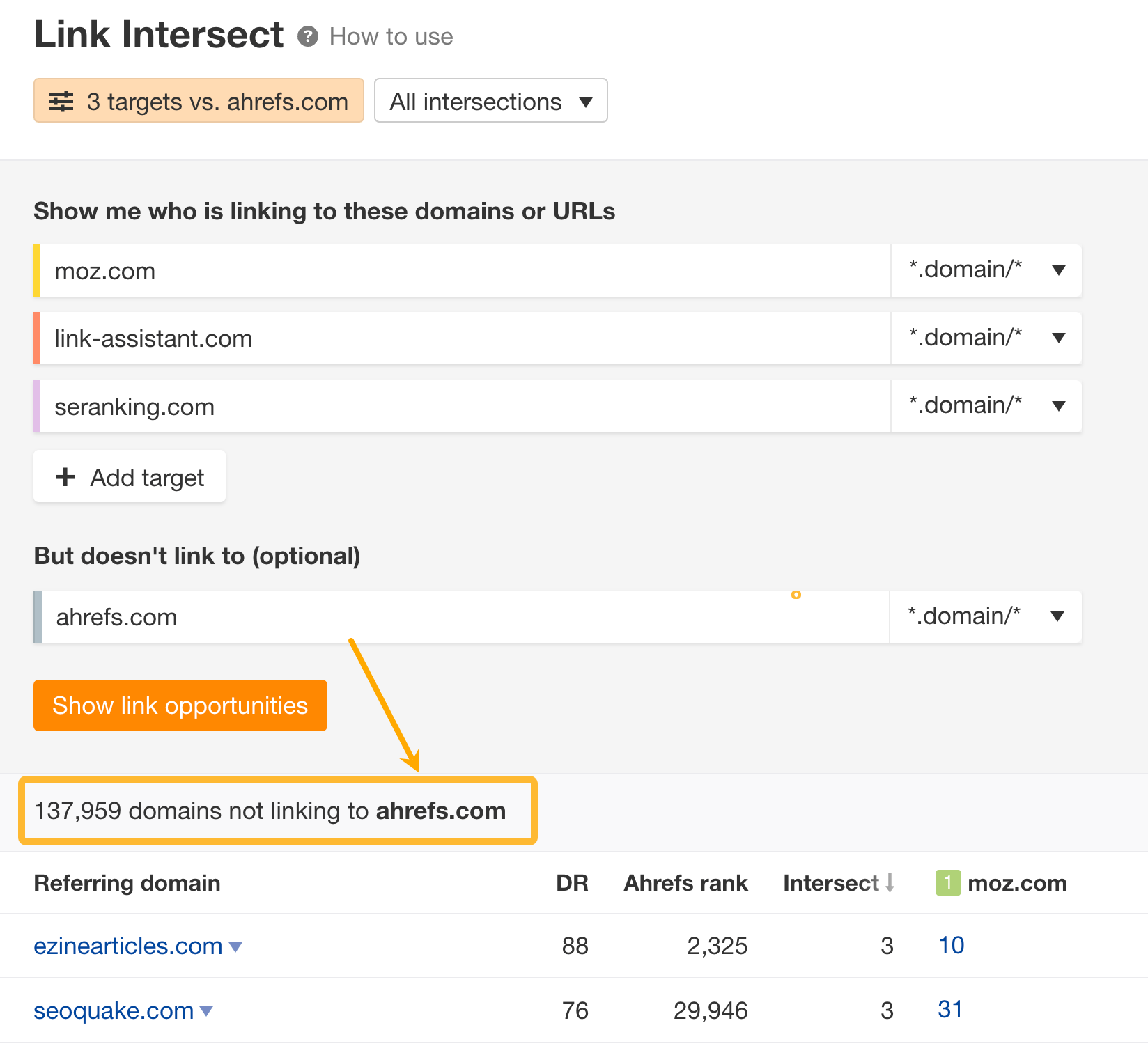
If you want to analyze the types of links your competitors are acquiring and which kind of content is being linked to, you can put a competitor’s URL into Site Explorer and view the Best by links report.
Not only can you see the content driving links to the site, but you can also see which websites are linking to those pages. This works great for building skyscrapers and linkable asset campaigns, especially if you are figuring out what type of content to build the campaign around.
Plus, you can filter the results to meet your evaluation criteria.
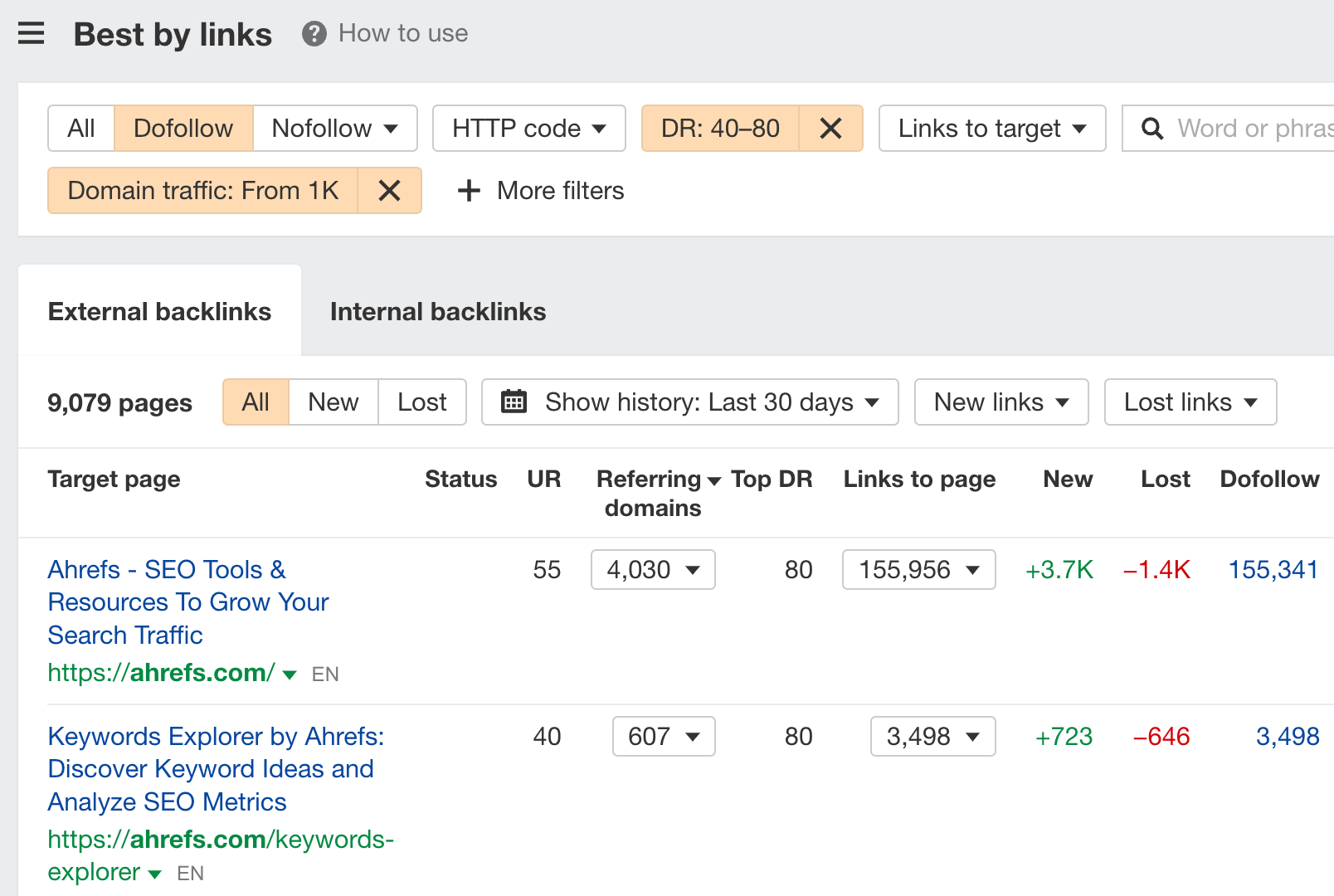
Another way to use competitor analysis (focusing on the Skyscraper Technique as an example) is to put the keyword for your intended skyscraper post into Ahrefs’ Keywords Explorer.
Using the SERP overview, you can see competing articles on the SERP, as well as the backlinks for each of those articles.
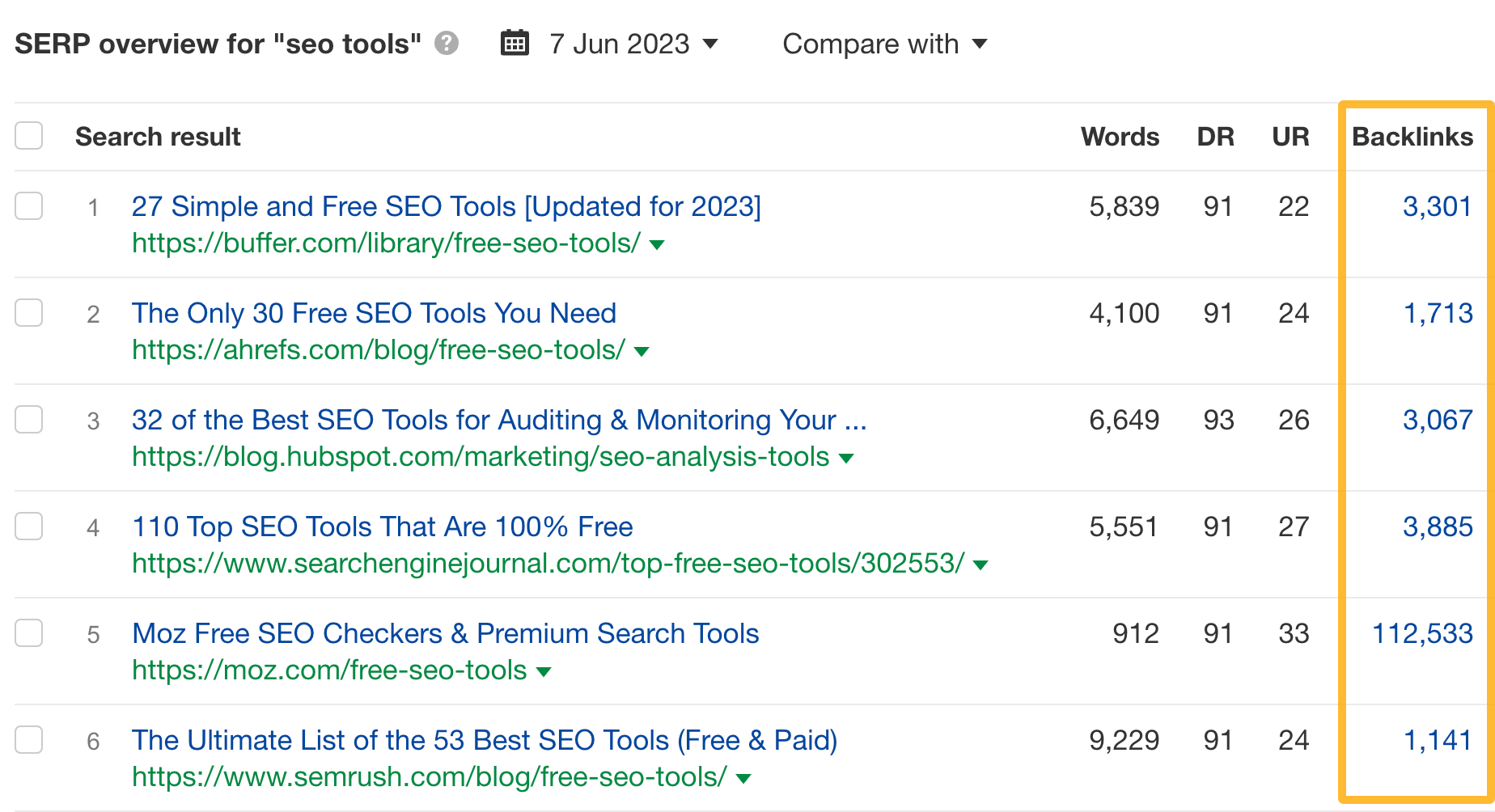
By clicking on the number of backlinks for a result, you will be taken to the Backlinks report for that page. You can filter the results to meet your evaluation criteria and simply export the list.
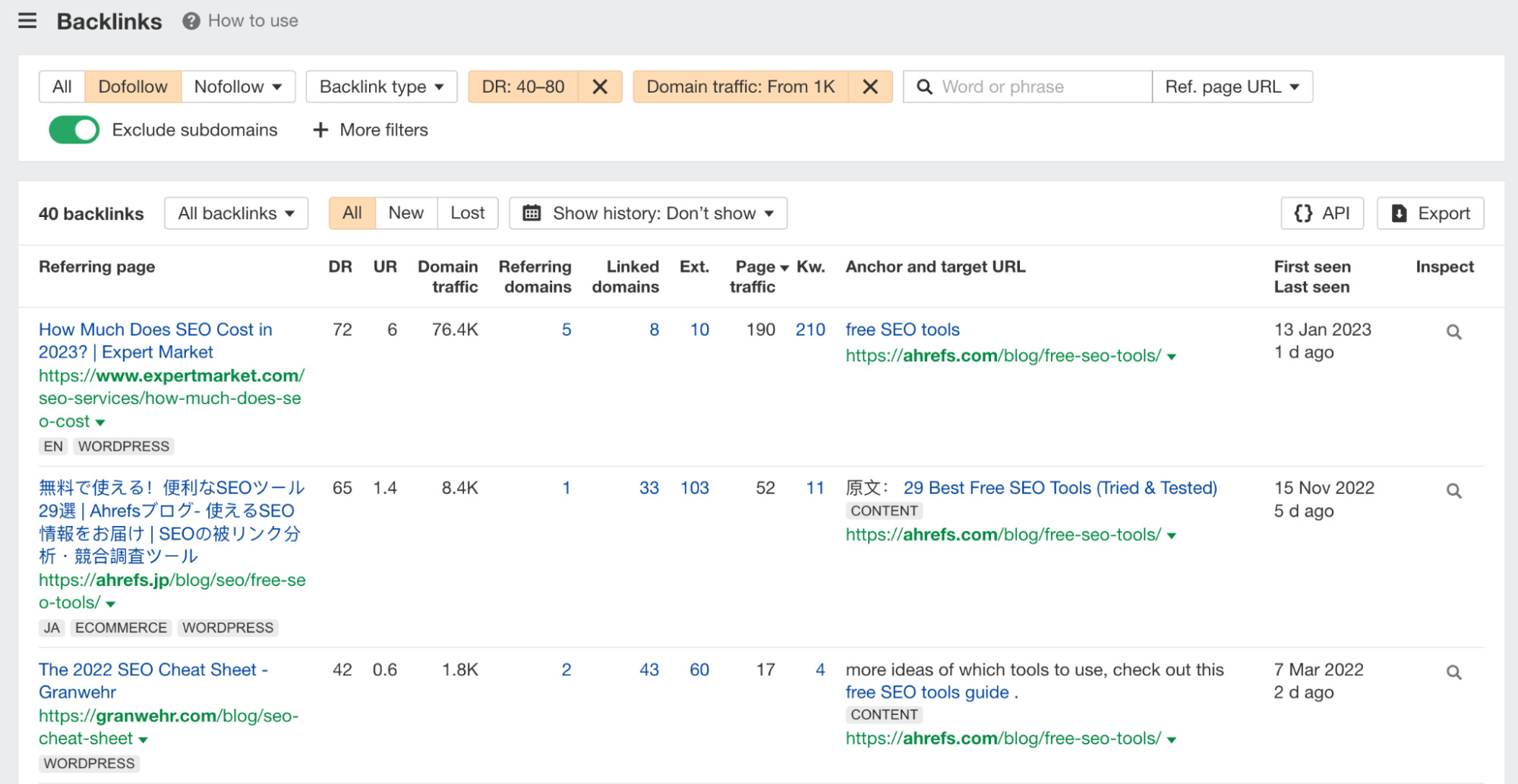
Finding prospects with Google and search operators
One of the easiest ways to find link prospects is to use Google with the help of some advanced search operators. Use terms that are relevant to your business or niche and add modifiers like “guest post” or “write for us” to narrow down the results.
Plus, if you use Ahrefs’ SEO Toolbar, you can see important site metrics like DR right in the search results, helping you narrow down prospects even faster.
There are many search operators you can use to help you build a comprehensive prospect list. As an example, let’s look at some search operators you can use if you are finding prospects for guest blogging:
- “Contribute”
- “Guest blogging spot”
- “Guest contributor”
- inurl:guest*author
- inurl:guest*blogger
- “guest blogger” + inanchor:contact
- “guest article” + inanchor:contact
Here’s an example of one of these in use:
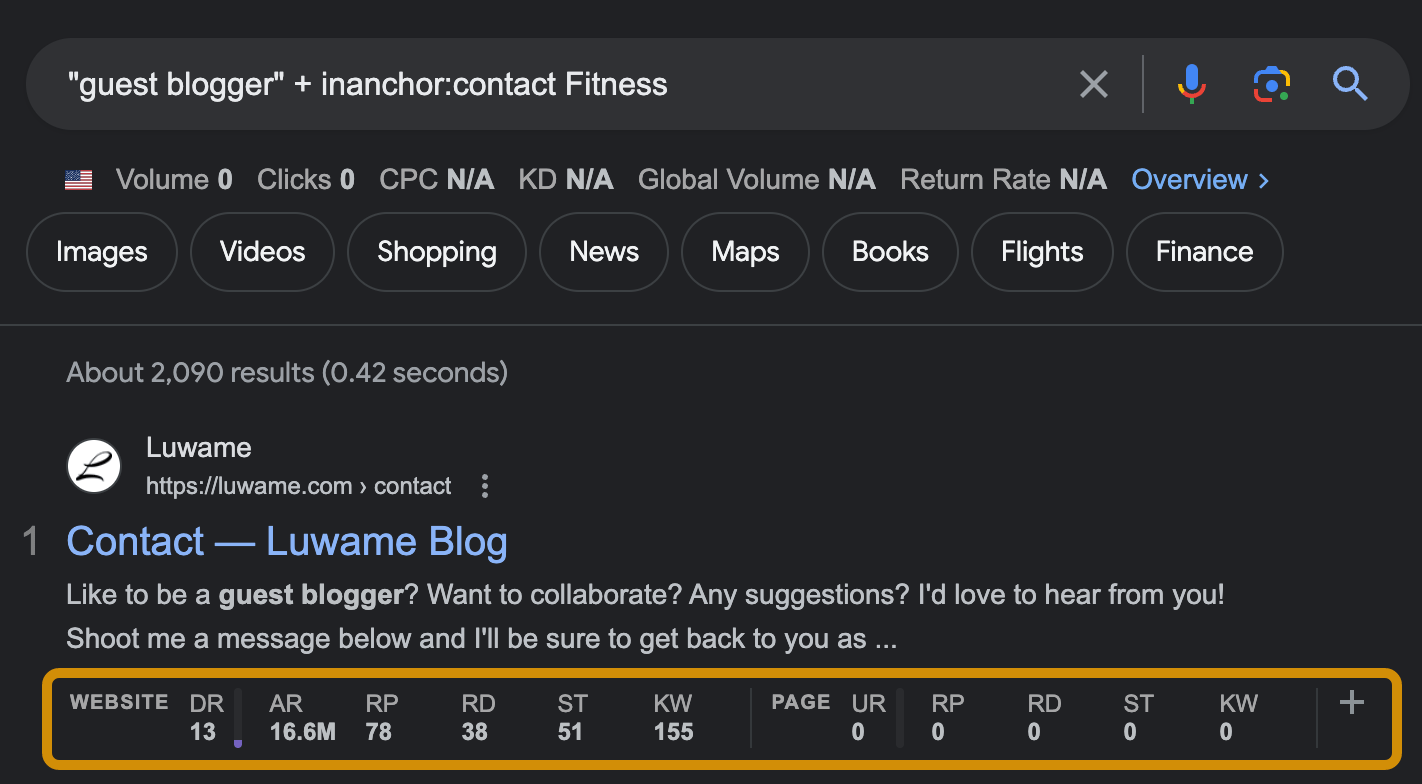
Using appropriate search operators, you can build a list of prospects into a spreadsheet. You can even automate the process with this free tool from LinkPitch.

Finding prospects with Content Explorer
Another great way of finding link prospects is by using Ahrefs’ Content Explorer. It allows you to find content on relevant topics.
This particular method for finding link prospects is great because it works for a number of different link building tactics.
First, using the “Pages” tab can help you find relevant content for potential niche edits. Also, if you visit the page and use Ahrefs’ SEO Toolbar, you can easily find invalid links for broken link building.
Moreover, with the “Authors” tab, you can find relevant authors and influencers to reach out to when starting a digital PR campaign.
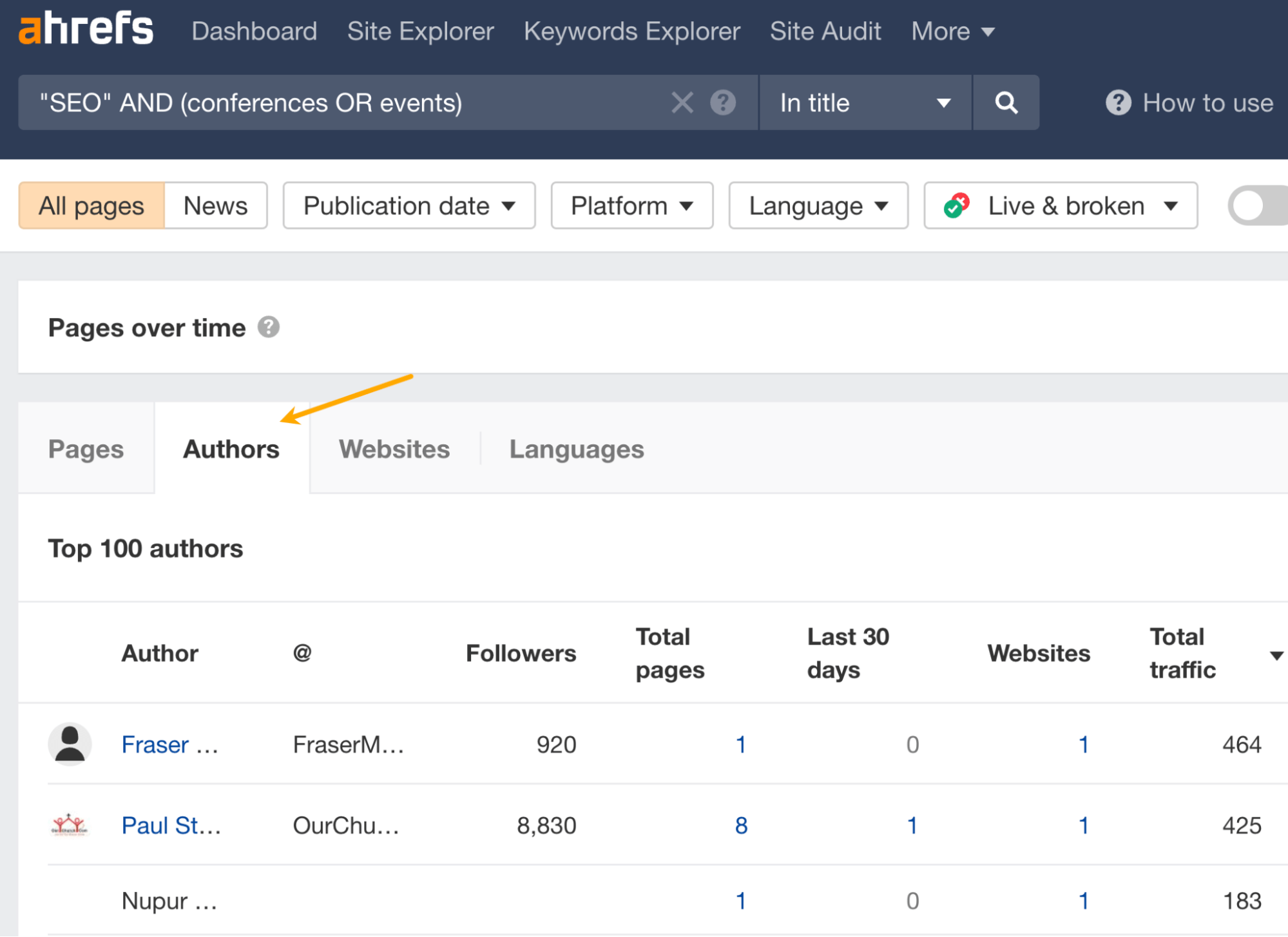
The best thing about using Content Explorer for link prospecting is that you can use advanced filters to ensure prospects meet your evaluation criteria. You can choose to show pages or websites within a certain DR range, with a specific website traffic or traffic value.
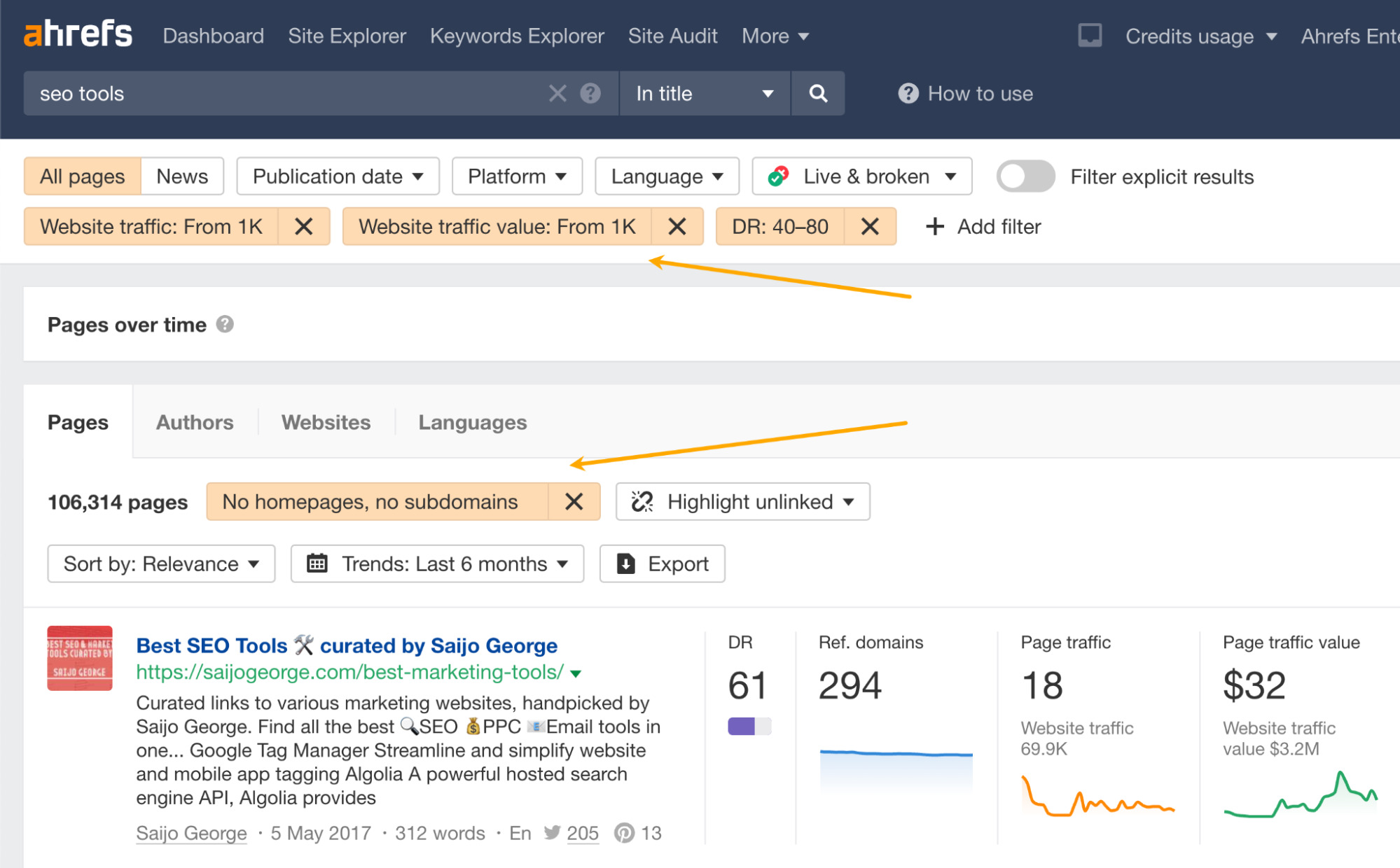
Plus, once your filters are applied, you can simply export the results into a spreadsheet.
Finding prospects with Web Explorer
Ahrefs’ new Web Explorer tool is a game changer for link building and is perfect for link prospecting.
The tool allows you to do a number of different things that make finding link prospects quick and easy. For example, you can find pages that are getting backlinks with specific keywords in the anchor text or topic-specific blogs that accept guest posts.
My personal favorite (as someone who does a lot of digital PR) is the fact you can find pages with unlinked brand mentions. You can simply export the results and reach out to a site, requesting it to add a link because it’s already mentioned your site!

Pro Tip
You can further expand your list of prospects by finding their “lookalikes.” See this video tutorial for more details:
Step 4. Analyze and evaluate link prospects for quality and relevance
Once you have gathered a list of potential link prospects, it’s time to evaluate them and prioritize the best ones. If you’ve been following your evaluation criteria, this should be a reasonably straightforward process.
Remember that we are looking initially at the evaluation criteria of relevance, Domain Rating, organic traffic, and traffic value.
Here are the metrics I tend to aim for:
- Relevance: Either niche relevant or relevant to my target audience, depending on the campaign
- Domain Rating: DR 40–80
- Organic traffic: 1000+ per month
- Traffic value: $1000+
These are the metrics I work with initially to qualify sites in the first overview stage.
However, it is important to note that you should be wary of metrics and not use them as your only way to determine the quality of a site. Many authority metrics can be manipulated, so it is always advisable to check each site to do your best and avoid spam.
Remember that although buying links is against Google’s guidelines, it has become a common practice in our industry. Many website owners know the potential to earn money from link placements.
For less experienced site owners who aren’t as adept at spotting spammy sites, there lies a great opportunity to throw up any old site designed solely to sell links. It’s in the interest of a site like this to manipulate metrics and look more authoritative than it is.
Here are some things to look for when spotting a spammy website:
- Little and/or poor-quality content
- Poor website design
- More display ads than content
- No “about” or “author” pages
- Individual posts without specific authors listed (attributed to “Editorial team,” for example)
- Individual posts with lots of outbound links
Here’s an example of a site meeting all of the evaluation criteria we’ve talked about:

However, when you visit the site, you can see it is poorly designed with a mass of poor-quality content. And for the most part, there are more display ads on the screen than actual content.
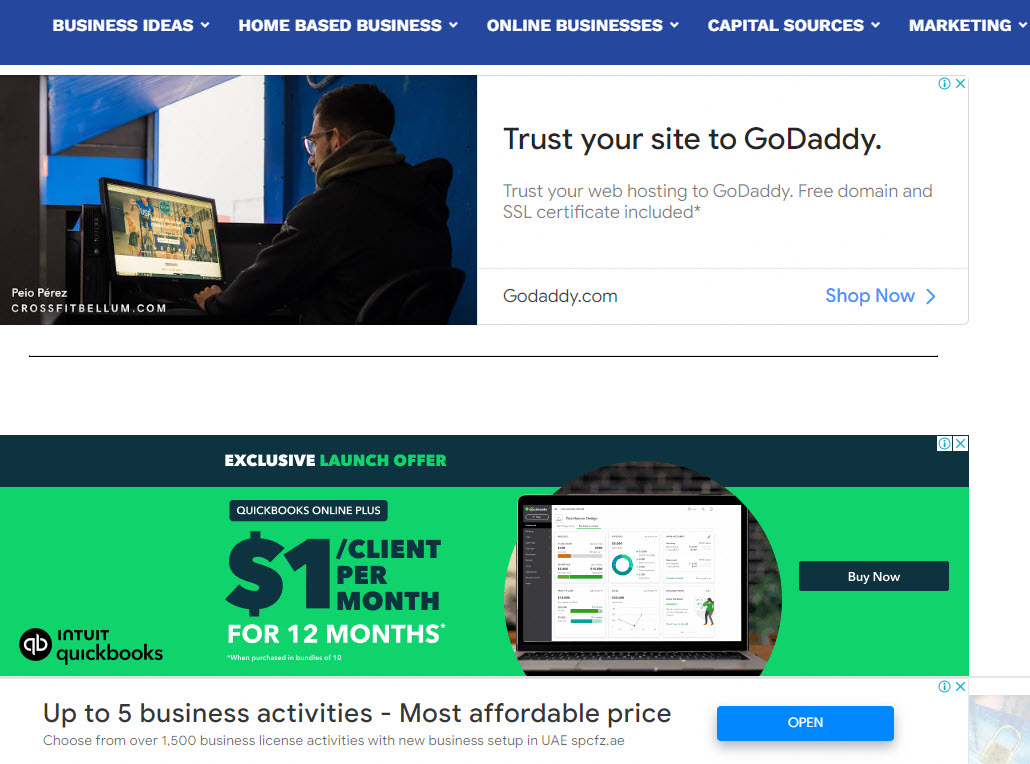
This is a prime example of why it pays to check out each site individually. Sites that don’t cut the mustard need to be removed from your prospect list.
Step 5. Find contacts for your prospects
The whole point of prospecting is to find sites to approach via outreach and acquire links from them. But you need contact details as part of your prospecting to reach out to them.
This will be the last step in narrowing down your list of prospects. Any potential sites you can’t find valid contact details for can be struck off your list.
The easiest way to do this is to use an email lookup tool like Hunter. This tool allows you to input any domain, bringing up all associated email addresses and information about the company.
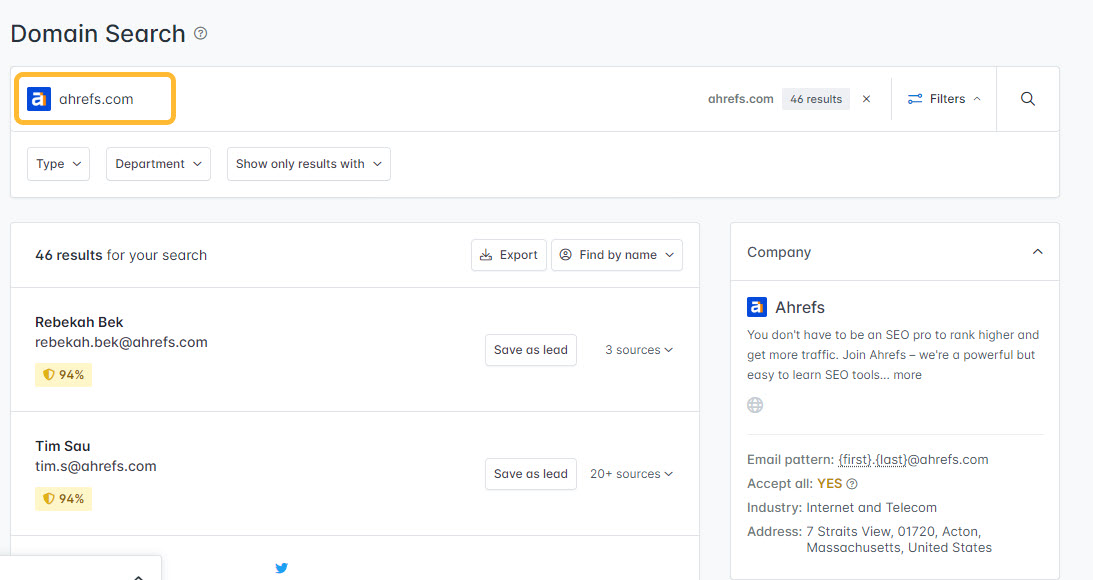
Then, once you have found relevant emails for your prospects, plug them into a tool like Pitchbox to start your outreach.
Final thoughts
Link prospecting is an essential part of SEO, and it’s important to take the time to do your research and evaluate link prospects properly.
Remember to always check for quality and trustworthiness. Google penalizes sites with low-quality backlinks, so make sure you don’t overlook any potential signs of spammy sites.
Once you have identified a list of high-quality sites relevant to your niche or target audience, you can start the outreach process and begin acquiring some awesome links for your site.
If you want to learn more, you can check out our videos on link prospecting in our Advanced Link Building course.
Got questions? Ping me on Twitter.
SEO
The 9 Best Landing Page Builders For 2024

Generating leads is crucial to boosting your sales – but if your landing pages aren’t effective, you’re going to struggle to turn visitors into customers.
Landing pages play a key role in elevating the effectiveness of your marketing efforts and differentiating, refining, and enhancing the user experience.
In this article, we’ll explore how to choose the right landing page builder for your business before highlighting the nine top landing page builders and what makes them stand out.
Let’s get into it.
Choosing The Right Landing Page Builder For Your Business
With so many options to choose from, how can you decide which landing page builder is right for you?
Here are a few things to consider when making your decision.
- Marketing objectives: Start by deciding what you want to achieve with your landing pages. Are you looking to collect email subscribers, drive sales, generate leads, or promote an event? Each platform caters to different use cases, so leading with your goals can help you refine your search.
- Ease of use: Different builders have different learning curves. If you’re a novice, you should probably opt for a tool that caters to beginners. If you have more technical experience, like coding knowledge, you might want to look to more advanced builders to get the most power.
- Integration needs: Do you want your landing pages to integrate with other software or tools you’re already using?
- Mobile optimization: It’s essential that your landing pages cater to mobile users, so make sure your builder considers that with features like responsive design.
- Budget constraints: Unfortunately, budget matters. Landing page builders come with various price tags depending on their capabilities and features. Make sure you’re working within the boundaries of what you can afford.
While this is, by no means, an exhaustive list of considerations, it’s a starting point to help you choose a landing page builder that makes sense for your business needs.
Now, let’s look at nine of the best landing page builders to choose from.
1. Carrd
- Best for: Simple projects, personal use, and small budgets.
Looking for a great landing page builder that won’t break the bank? Look no further than Carrd.
Carrd is a streamlined landing page builder that focuses on creating single-page websites quickly and easily. It’s designed for simplicity, making it ideal for anyone who wants to quickly create a webpage without needing to build a multi-page site.
Think portfolios, personal profiles, project presentations, and small business showcases.
Carrd’s user-friendly interface and selection of themes allow users to create sleek pages in the blink of an eye without even needing an account – you can just visit the website, pick a theme, and get started. However, you will need to sign up to save or publish your site.
It balances simplicity and functionality to help you craft that pages are clean, focused, and responsive across all devices. If you’re just testing the waters or working with slim budgets, this is the right tool for you.
Pros:
- Extremely affordable, with a free tier available.
- Intuitive and user-friendly interface.
- Responsive design.
- Fast and lightweight, making it ideal for quick and simple sites.
Cons:
- Limited to single-page websites.
- Restrictive layouts/themes, which limit creative freedom.
- Lacks advanced features and integrations found in more comprehensive builders.
Pricing:
- Carrd’s free basic plan allows you to launch three sites with Carrd branding to .carrd.co domains.
- Paid plans range from $9 to $49 per year, and offer additional features like no Carrd branding, custom domains, and Google Analytics support (depending on your membership tier).
2. ConvertKit
 Screenshot from ConvertKit.com, April 2024
Screenshot from ConvertKit.com, April 2024- Best for: Content creators, bloggers, and marketers focused on growing their audience through email.
Billing itself as “the creator marketing platform,” ConvertKit’s landing page builder is targeted at creators, bloggers, and marketers who want to expand their email subscriber base.
If your goal is to create a landing page to help you build an email list, ConvertKit might be the right option for you.
ConvertKit’s landing page builder offers a range of high-quality, customizable templates and integrates with third-party tools to help you get the most out of your site.
It also integrates with the stock photo platform Unsplash to offer access to 100,000+ free images for your landing page.
While ConvertKit’s analytics and customization options might not be as extensive as those of some of its competitors, its ease of use and focused approach make it a standout for email-driven campaigns.
Pros:
- No cost for starting (up to 1,000 subscribers).
- Access to thousands of free images.
- Robust third-party integration capabilities.
Cons:
- Limited template customization and flexibility.
- A/B testing and analytics features are less advanced.
- Priced higher than some basic landing page builders.
Pricing:
- Free plan for up to 10,000 subscribers.
- The Creator plan starts at $25/month and includes benefits like automation features and app integrations. Pricing scales are based on subscriber count.
3. Unbounce
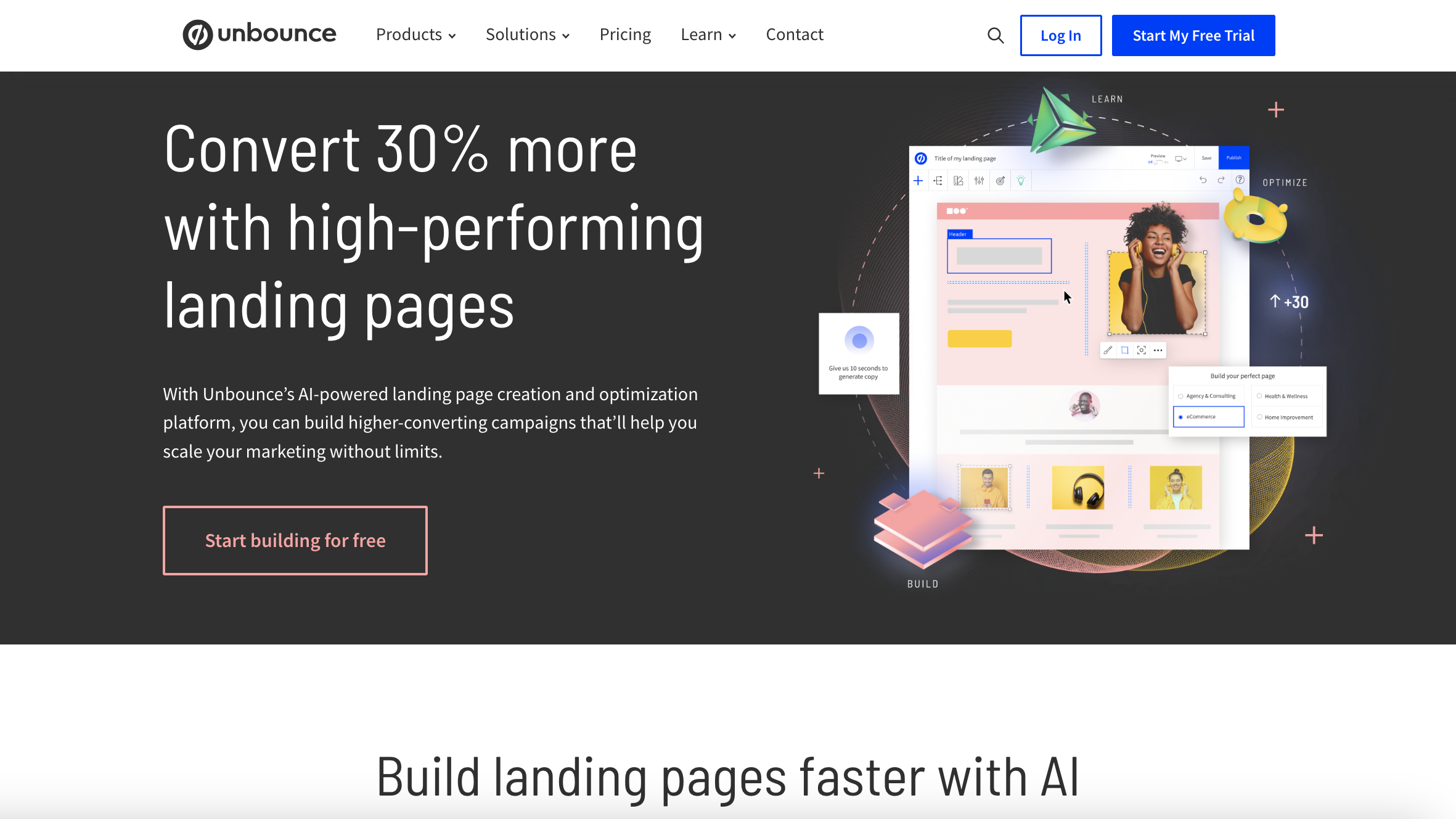 Screenshot from Unbounce.com, April 2024
Screenshot from Unbounce.com, April 2024Unbounce is a leading landing page builder renowned for its focus on conversion rate optimization (CRO). Its website promises to help you “build high-converting landing pages with ease.”
It offers a suite of advanced tools, such as A/B testing, dynamic text replacement, and the Smart Traffic system, which uses AI to optimize visitor flow to the highest-converting page variant based on user behavior and characteristics.
It also focuses on features that can help you boost your lead gen efforts, such as opt-in email popups and sticky banners.
With 100+ responsive templates, Unbound makes it easy to create landing pages that are both engaging and effective.
Compared to some other options on this list, Unbounce is a particularly robust platform with tons of customization and integrations – and the price point reflects that.
As a premium offering with a steeper learning curve, it might not be the best for beginners – but its AI-powered features and conversion-focused tools make it a formidable tool for achieving your goals.
Pros:
- Advanced A/B testing and AI-driven optimization.
- Large selection of responsive templates.
- Integrated features for enhancing lead capture.
Cons:
- Higher price point than some other builders, which might not work for those with limited budgets.
- Complex setup and steeper learning curve for new users.
- Some customization limitations.
Pricing
- The Build plan starts at $74/month and covers unlimited conversions, one root domain, and up to 20,000 monthly unique visitors.
- Other paid plans range from $112/month up to $649/month.
4. Leadpages
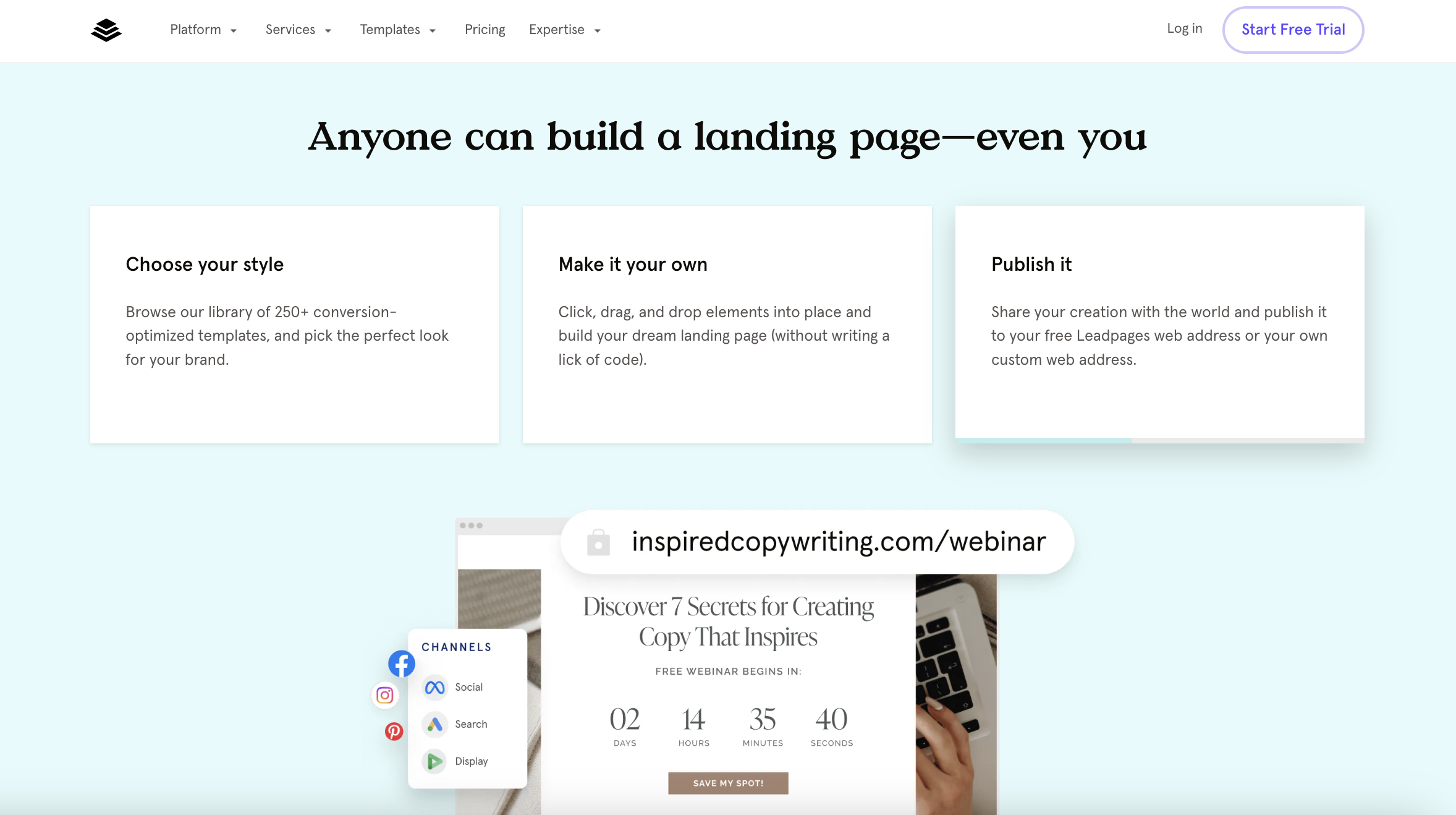 Screenshot from Leadpages.com, April 2024
Screenshot from Leadpages.com, April 2024- Best for: Small businesses and entrepreneurs looking to generate sales.
Need a landing page that will help you generate sales? Consider taking a look at Leadpages.
Its strength lies in its user-friendly, drag-and-drop editor and an extensive collection of templates that streamline the page-building process. Plus, according to the Leadpages website, it’s a platform that converts five times better than the industry average.
Leadages offers CRO tools, real-time analytics, and A/B testing capabilities, enabling users to enhance their page performance effectively.
Its various widgets allow you to add videos, images, forms, and even payment integrations directly onto your landing pages, making it a versatile tool for businesses that want to combine content with sales functionality.
On top of all this, Leadpages now includes an AI Engine for creating headlines and images and an AI writing assistant at some membership tiers, which can help you write better content.
Pros:
- Intuitive no-code editor and easy payment integration.
- Comprehensive A/B testing and real-time analytics.
- Extensive template library with over 250 options.
Cons:
- Higher cost compared to some alternatives.
- Limited ecommerce features and potential mobile responsiveness issues.
- Some users report mobile responsiveness issues.
Pricing:
- The standard plan starts at $37/month for one custom domain, unlimited traffic and leads, and 10,000 monthly AI Engine credits.
- More advanced features are available in higher-tier plans, which start at $74/month.
5. Landingi
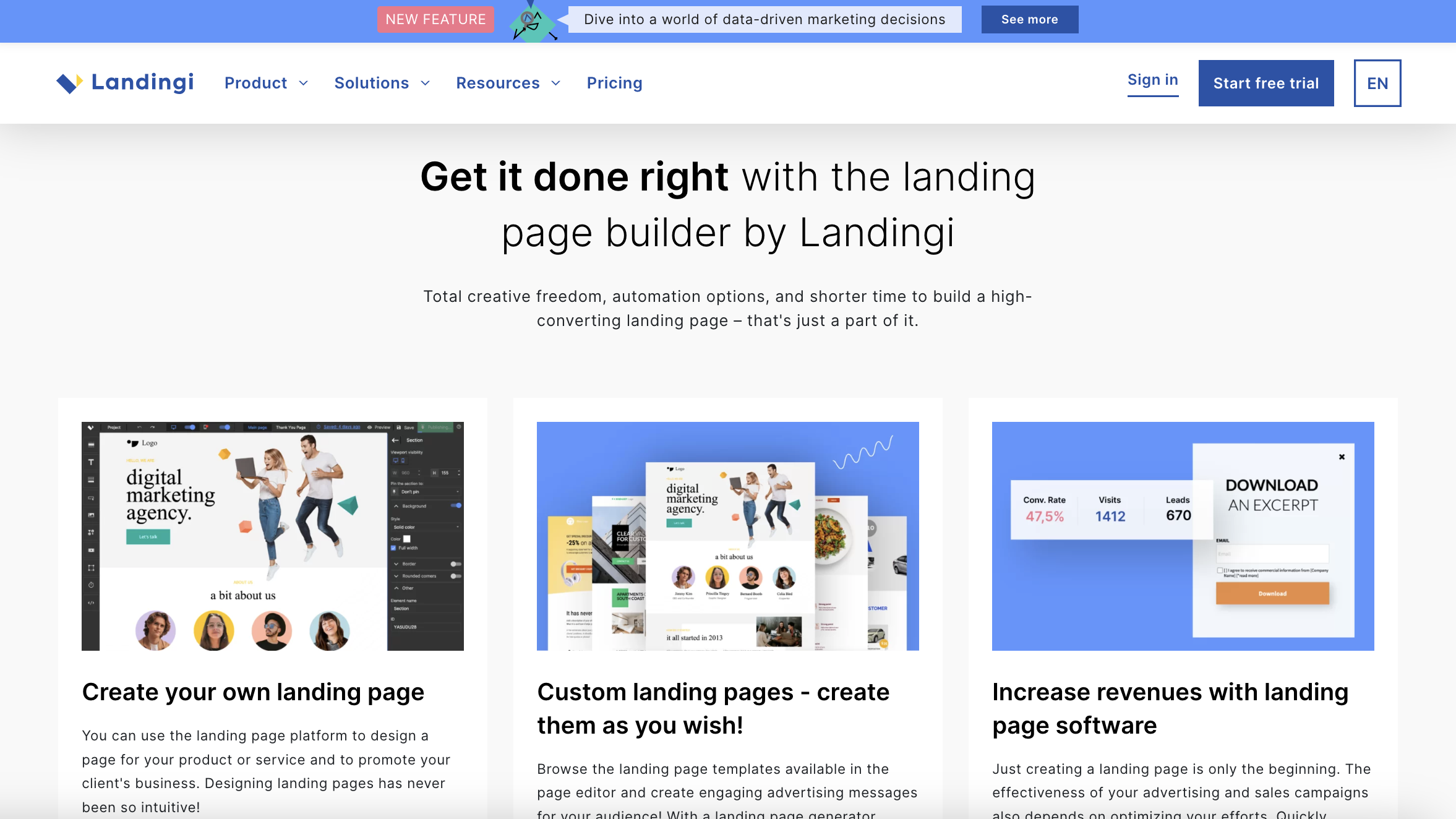 Screenshot from Landingi.com, April 2024
Screenshot from Landingi.com, April 2024- Best for: Businesses seeking a versatile landing page solution with a wide range of features.
If you’re in the market for versatility, Landingi is worth investigating.
Landingi offers a flexible, comprehensive landing page builder with a robust set of features, including an advanced editor, popups, A/B testing, and a substantial library of 300+ templates.
Its unique Smart Sections feature allows you to reuse and easily update specific page elements across multiple designs, saving time and headaches.
Designed to serve businesses of all sizes, Landingi’s simple, drag-and-drop builder can help you create and optimize various types of landing pages – and if you have any HTML and CSS knowledge, it can be a pretty impressive editor.
Landingi is a particularly strong choice for small businesses looking to target different customer segments with unique landing pages. The integration capabilities with numerous apps, including payment gateways like Stripe, make it a great choice for companies looking to sell products.
While its rich feature set can be overwhelming for newcomers, and creating pages might take a bit longer compared to other platforms, the level of customization and control it offers makes Landingi one of the best landing page builders out there.
Pros:
- Extensive template library with 300+ customizable options.
- Powerful editing capabilities with Smart Sections for efficient design.
- Broad integration with various apps, including payment systems.
Cons:
- Steeper learning curve for beginners.
- Potentially longer time to create landing pages compared to simpler platforms.
Pricing:
- The Lite plan starts at $35/month and gives you 10 digital assets, unlimited conversions, 5,000 visits per month, and one custom domain.
- Landingi also offers Professional and Unlimited tiers with more advanced features and capabilities.
6. Instapage
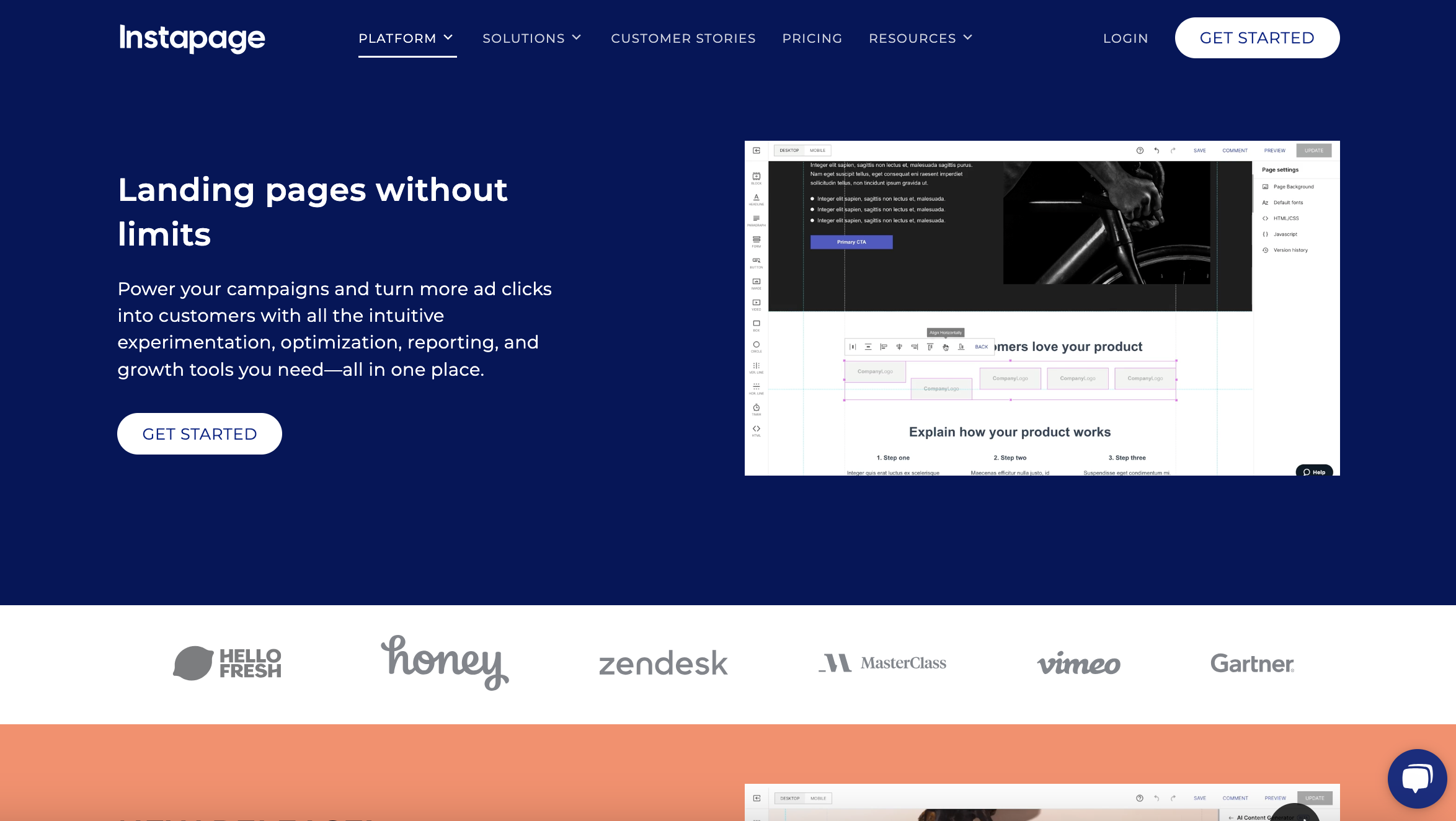 Screenshot from Instapage.com, April 2024
Screenshot from Instapage.com, April 2024- Best for: Large businesses, marketing teams, or agencies that require collaboration and advanced optimization features.
If you’re seeking a more high-end landing page platform, Instapage might be the one for you. It offers advanced features tailored for professional marketing teams and agencies with a need to create optimized landing pages at scale.
In addition to a drag-and-drop builder and plenty of high-quality templates, Instapage offers a bevy of features, including advanced cloud-based team collaboration tools, heatmaps for user engagement analysis, robust A/B testing capabilities, AI-generated content creation, and more.
One of its standout features is Instablocks, which allows users to create custom page components that can be easily reused across different projects.
Instapage supports advanced marketing goals with features like AdMap to align ads with page content. Plus, its mobile-friendly design ensures a fast, seamless user experience.
While Instapage offers a premium experience with its comprehensive set of tools and features, its higher price point and complex functionalities may be a barrier for smaller businesses or those new to landing page optimization.
Pros:
- Extensive customization with a library of professional templates.
- Instablocks for efficient design and asset reuse.
- Effective team collaboration features.
Cons:
- Premium pricing will be a barrier for many businesses.
- Steep learning curve for utilizing advanced features.
- Limitations in reporting and visitor tracking for lower-tier plans.
Pricing:
- The Build plan starts at $199/month, with a 14-day free trial.
- Customers will need to upgrade to a customized Convert plan to access some of the more complex features, such as AdMap, heatmaps, and more.
7. Wix
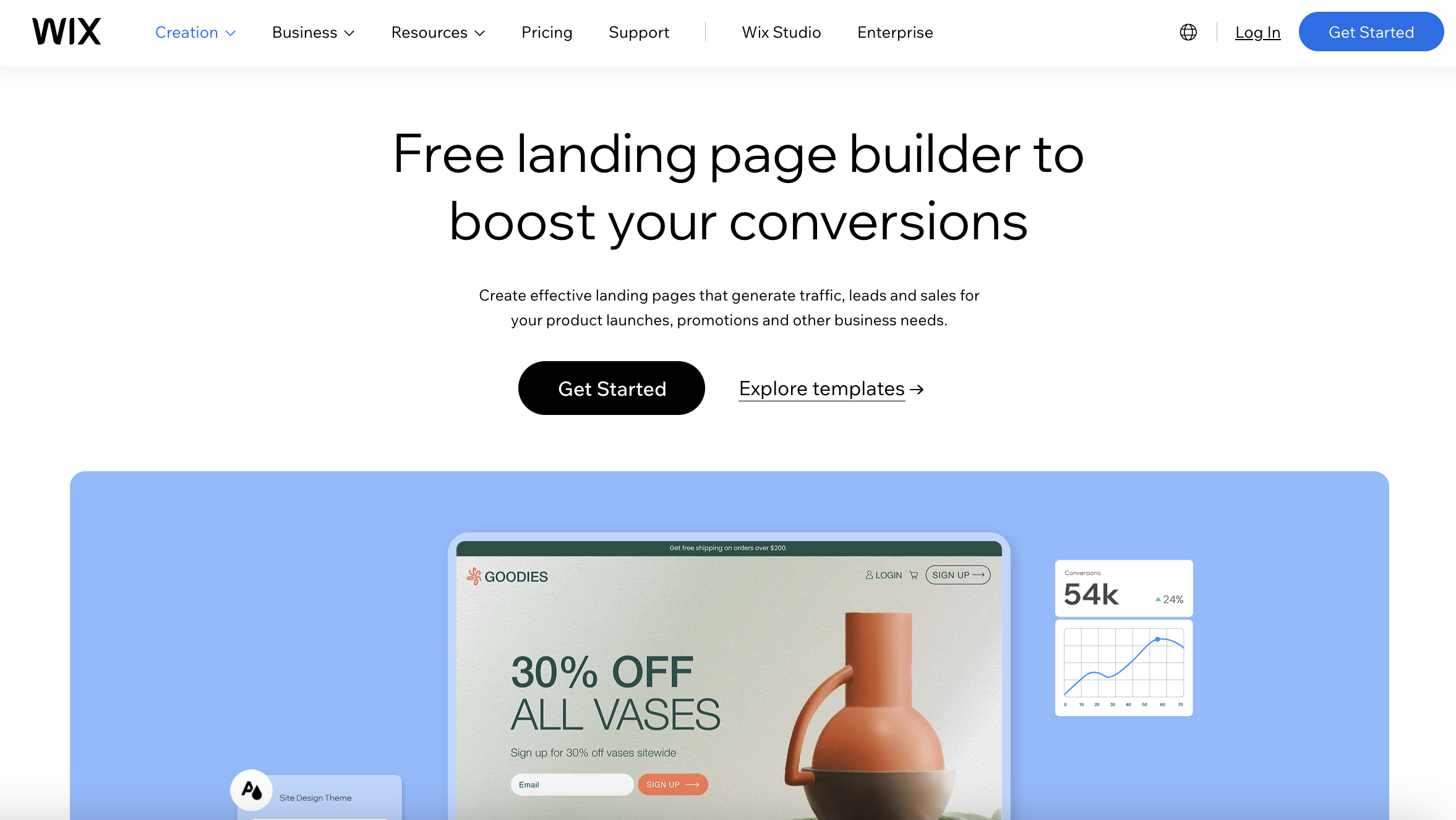 Screenshot from Wix.com, April 2024
Screenshot from Wix.com, April 2024- Best for: Individuals and small businesses seeking creative control without advanced coding.
Now for something much more accessible: Wix is renowned for its user-friendly platform, which is ideal for creating attractive landing pages with minimal effort.
Like other options on this list, Wix offers an accessible drag-and-drop editor and a range of existing templates to help users craft aesthetically pleasing and functional landing pages.
Wix’s platform has a reputation for being particularly beginner-friendly, with a low learning curve and a free plan to help new users get started without any upfront investment.
For those focused on ecommerce, Wix provides specific features to build landing pages that showcase products and promotions, supported by over 50 payment solutions and tools like heatmaps to enhance user engagement and conversion rates.
While it offers a free starter plan, accessing more advanced functionalities and removing Wix ads requires upgrading to a paid subscription.
Wix’s balance of user-friendly design tools, ecommerce support, and cost-effective pricing makes it a favorable option for those new to web design or businesses needing straightforward, visually appealing landing pages.
Pros:
- User-friendly with an intuitive drag-and-drop interface.
- Free plan available, making it accessible for beginners.
- Ecommerce capabilities with extensive payment integration.
Cons:
- Advanced features and ad-free experience require a paid plan.
- Potential limitations in customization for complex requirements.
- Site speed may decrease with more intricate designs.
Pricing:
- A free plan is available, but it includes Wix branding and lacks more advanced features like payments.
- Paid plans start at $17/month, offering additional features.
8. Elementor
 Screenshot from Elementor.com, April 2024
Screenshot from Elementor.com, April 2024- Best for: WordPress users looking for a powerful and intuitive landing page builder.
If you’re a WordPress user, you’ll want to know about Elementor.
It’s a WordPress page builder that has gained popularity for its flexibility, comprehensive customization capabilities, and user-friendly interface.
Elementor allows users to design dynamic and detailed landing pages within WordPress. This feature makes it the perfect choice for WordPress users who want to extend the functionality of their website with sleek landing pages that maintain a consistent look and feel with their existing content.
Its real-time editing features allow for immediate feedback on design changes without any coding.
It also offers dozens of designer-made templates to choose from. You can add custom forms and popups to your landing page, save page components for reuse, and seamlessly integrate with your customer relationship management (CRM) tools to create a powerful customer experience.
While Elementor offers a ton in terms of design flexibility and integration, it’s important to note that it’s exclusively for WordPress users and can be resource-intensive – so it might impact site performance, especially on more complex websites.
Pros:
- Advanced customization and design flexibility.
- Real-time editing and instant feedback.
- Seamless WordPress integration.
Cons:
- Exclusively for WordPress users.
- Potentially impacts site performance due to resource intensity.
Pricing:
- Free version with limited functionality.
- Paid versions start at $59/year, providing advanced features and support.
9. Taplink
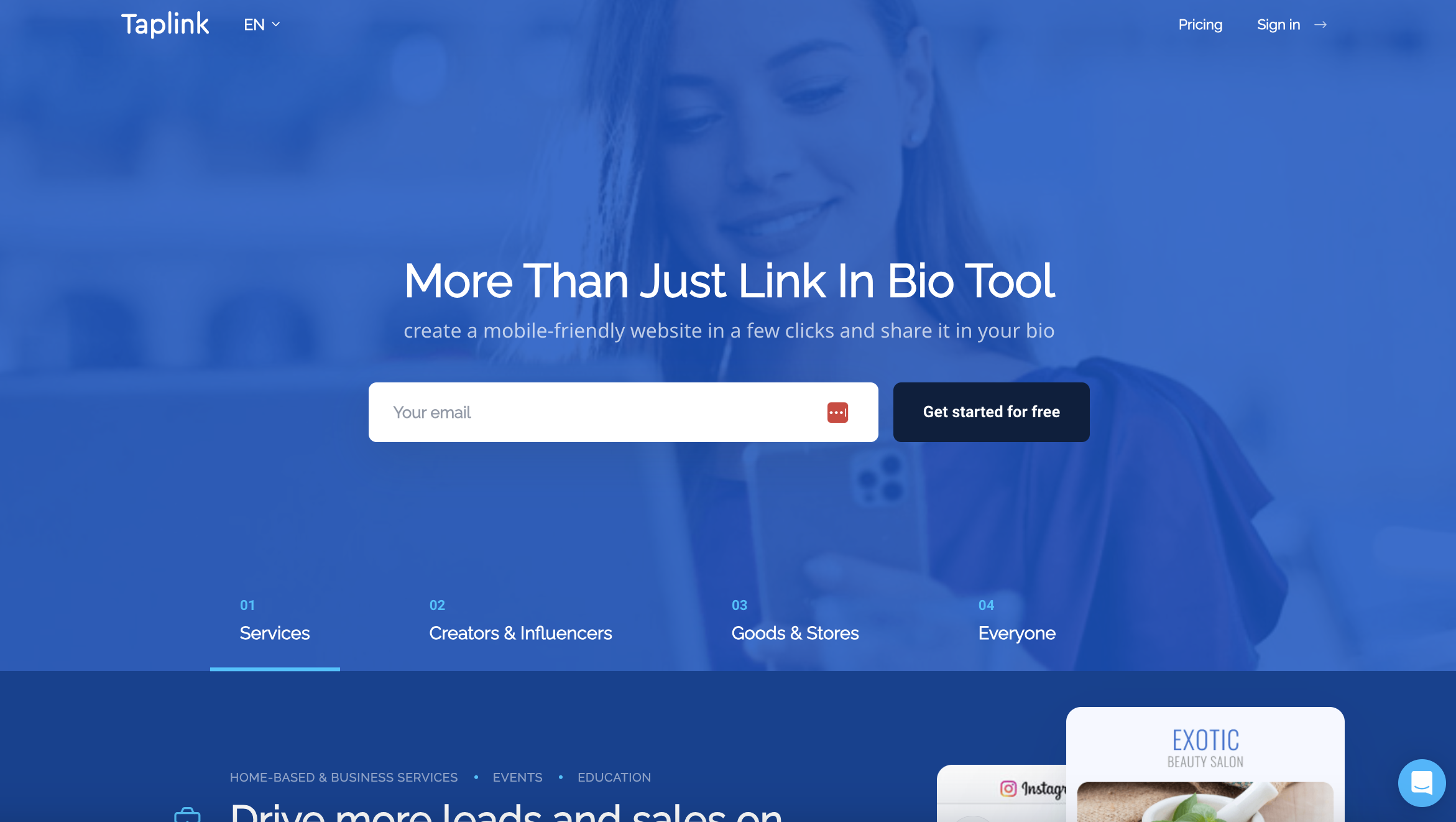 Screenshot from Taplink.at, April 2024
Screenshot from Taplink.at, April 2024- Best for: Social media influencers and businesses looking to direct traffic from social platforms to other content or actions.
This one’s a little different than some of the other examples here, but it deserves highlighting.
Taplink is a specialized micro-landing page builder optimized for social media profiles. It’s perfect for businesses and influencers that want to drive traffic from social media to other content or actions. You just use Taplink to create landing pages and share them on your social profiles.
Taplink stands out for its simplicity and mobile optimization, which is crucial when targeting social media audiences.
The focus on quick, effective page creation allows users to engage with their audience without the complexities of traditional website development.
For those aiming to convert social media interest into tangible outcomes – such as lead generation, sales, or content promotion – Taplink is a winner.
While its feature set is more limited than some of the more comprehensive builders featured here, its affordability and user-friendly design make it a great tool for those looking to maximize their social engagement with minimal effort and investment.
Pros:
- Simple and quick setup.
- Mobile-optimized for social media engagement.
- Cost-effective for targeted campaigns.
Cons:
- Designed primarily for micro-landing pages, limiting the scope.
- Fewer features and customization options than extensive landing page builders.
Pricing:
- Taplink offers a free basic plan, with premium features available on paid plans starting from $3/month. The most expensive tier, the Business tier, is $6/month.
There’s A Landing Page Platform To Help You Convert Visitors
Choosing the right landing page builder for your business can significantly impact your marketing success – but the decision will depend on your specific goals and needs.
As we’ve explored, each tool has unique strengths and caters to different aspects of the landing page creation and optimization process.
Whether you’re looking for advanced design capabilities, a user-friendly interface, or specific functionalities like CRO, there’s a platform that can help you not just streamline your landing page design process, but start converting visitors into loyal customers.
More resources:
Featured Image: Griboedov/Shutterstock
SEO
Google’s Search Engine Market Share Drops As Competitors’ Grows

According to data from GS Statcounter, Google’s search engine market share has fallen to 86.99%, the lowest point since the firm began tracking search engine share in 2009.
The drop represents a more than 4% decrease from the previous month, marking the largest single-month decline on record.
U.S. Market Impact
The decline is most significant in Google’s key market, the United States, where its share of searches across all devices fell by nearly 10%, reaching 77.52%.
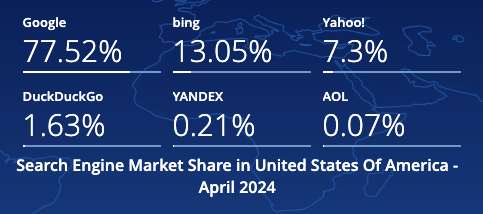 Screenshot from: https://gs.statcounter.com/search-engine-market-share/, May 2024.
Screenshot from: https://gs.statcounter.com/search-engine-market-share/, May 2024.Concurrently, competitors Microsoft Bing and Yahoo Search have seen gains. Bing reached a 13% market share in the U.S. and 5.8% globally, its highest since launching in 2009.
Yahoo Search’s worldwide share nearly tripled to 3.06%, a level not seen since July 2015.
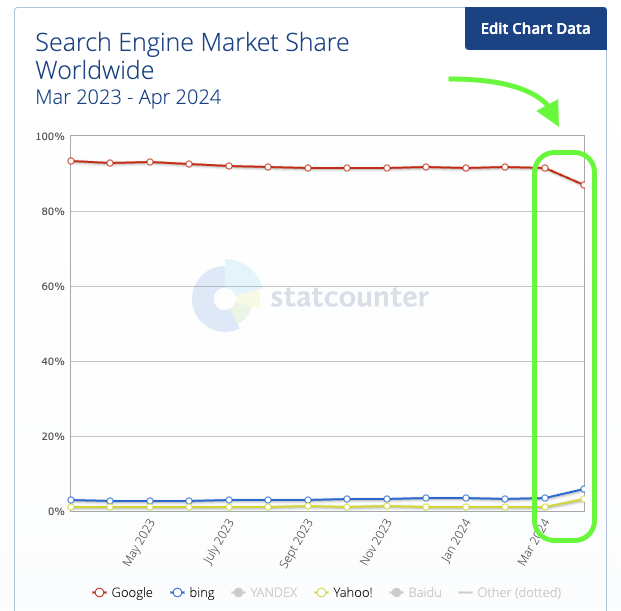 Screenshot from: https://gs.statcounter.com/search-engine-market-share/, May 2024.
Screenshot from: https://gs.statcounter.com/search-engine-market-share/, May 2024.Search Quality Concerns
Many industry experts have recently expressed concerns about the declining quality of Google’s search results.
A portion of the SEO community believes that the search giant’s results have worsened following the latest update.
These concerns have begun to extend to average internet users, who are increasingly voicing complaints about the state of their search results.
Alternative Perspectives
Web analytics platform SimilarWeb provided additional context on X (formerly Twitter), stating that its data for the US for March 2024 suggests Google’s decline may not be as severe as initially reported.
From our data (Search Engine website category, US, March 2024) it doesn’t look like we’re there yet: pic.twitter.com/RBUJp4ZLeb
— Similarweb (@Similarweb) May 1, 2024
SimilarWeb also highlighted Yahoo’s strong performance, categorizing it as a News and Media platform rather than a direct competitor to Google in the Search Engine category.
Don’t underestimate Yahoo. They’re doing great. On our platform they’re categorized as News and Media, and hence not a direct competitor to Google in the Search Engine category. But they rank #10 worldwide, #6 in the US, and #1 in their category. Much higher than Bing and OpenAI. pic.twitter.com/O4yJu5QEK6
— Similarweb (@Similarweb) May 2, 2024
At the same time, Google is slightly declining 👀 pic.twitter.com/9i7paeU1QG
— Similarweb (@Similarweb) May 2, 2024
Why It Matters
The shifting search engine market trends can impact businesses, marketers, and regular users.
Google has been on top for a long time, shaping how we find things online and how users behave.
However, as its market share drops and other search engines gain popularity, publishers may need to rethink their online strategies and optimize for multiple search platforms besides Google.
Users are becoming vocal about Google’s declining search quality over time. As people start trying alternate search engines, the various platforms must prioritize keeping users satisfied if they want to maintain or grow their market position.
It will be interesting to see how they respond to this boost in market share.
What It Means for SEO Pros
As Google’s competitors gain ground, SEO strategies may need to adapt by accounting for how each search engine’s algorithms and ranking factors work.
This could involve diversifying SEO efforts across multiple platforms and staying up-to-date on best practices for each one.
The increased focus on high-quality search results emphasizes the need to create valuable, user-focused content that meets the needs of the target audience.
SEO pros must prioritize informative, engaging, trustworthy content that meets search engine algorithms and user expectations.
Remain flexible, adaptable, and proactive to navigate these shifts. Keeping a pulse on industry trends, user behaviors, and competing search engine strategies will be key for successful SEO campaigns.
Featured Image: Tada Images/Shutterstock
SEO
How To Drive Pipeline With A Silo-Free Strategy
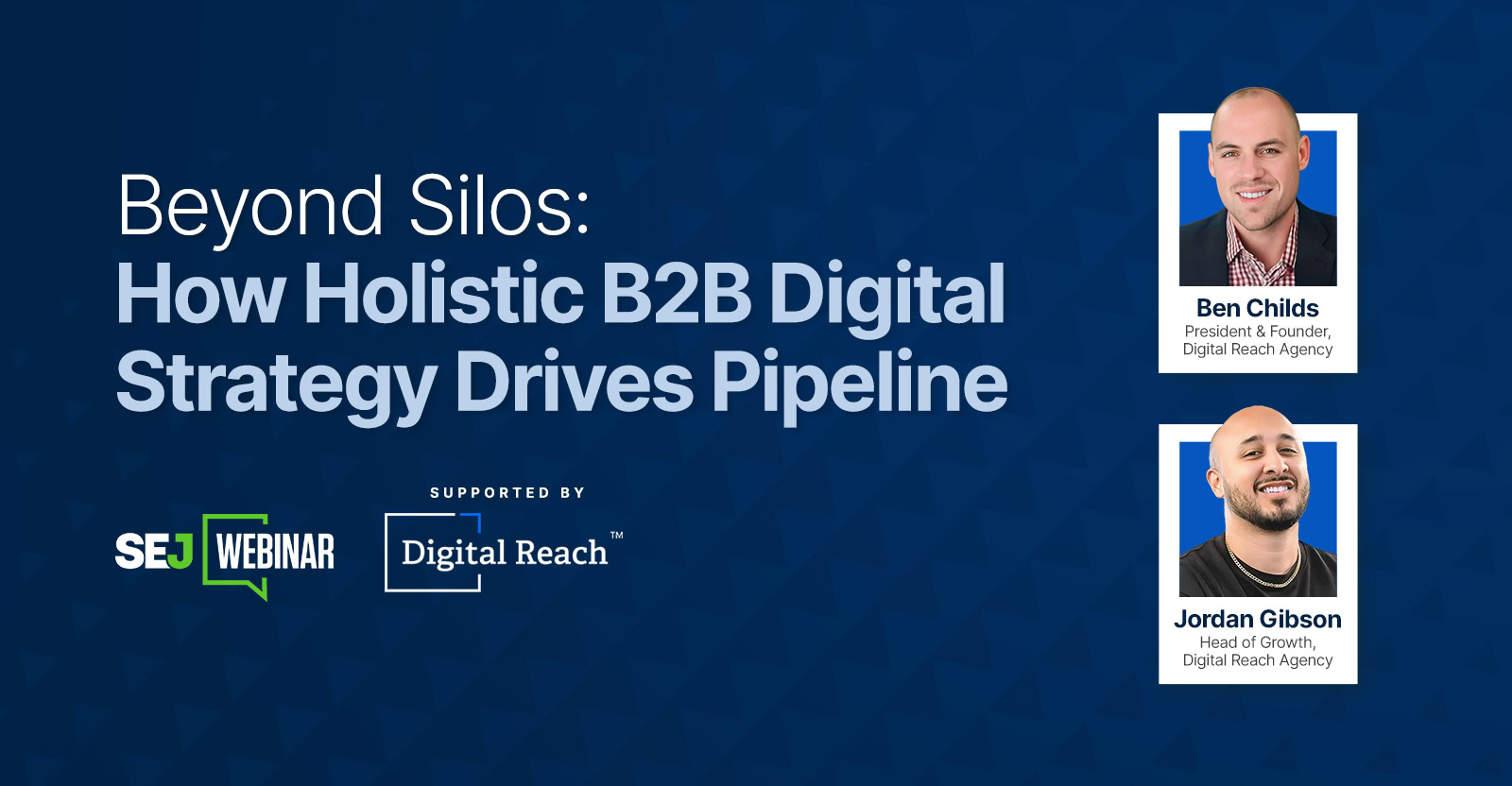
When it comes to B2B strategy, a holistic approach is the only approach.
Revenue organizations usually operate with siloed teams, and often expect a one-size-fits-all solution (usually buying clicks with paid media).
However, without cohesive brand, infrastructure, and pipeline generation efforts, they’re pretty much doomed to fail.
It’s just like rowing crew, where each member of the team must synchronize their movements to propel the boat forward – successful B2B marketing requires an integrated strategy.
So if you’re ready to ditch your disjointed marketing efforts and try a holistic approach, we’ve got you covered.
Join us on May 15, for an insightful live session with Digital Reach Agency on how to craft a compelling brand and PMF.
We’ll walk through the critical infrastructure you need, and the reliances and dependences of the core digital marketing disciplines.
Key takeaways from this webinar:
- Thinking Beyond Traditional Silos: Learn why traditional marketing silos are no longer viable and how they spell doom for modern revenue organizations.
- How To Identify and Fix Silos: Discover actionable strategies for pinpointing and sealing the gaps in your marketing silos.
- The Power of Integration: Uncover the secrets to successfully integrating brand strategy, digital infrastructure, and pipeline generation efforts.
Ben Childs, President and Founder of Digital Reach Agency, and Jordan Gibson, Head of Growth at Digital Reach Agency, will show you how to seamlessly integrate various elements of your marketing strategy for optimal results.
Don’t make the common mistake of using traditional marketing silos – sign up now and learn what it takes to transform your B2B go-to-market.
You’ll also get the opportunity to ask Ben and Jordan your most pressing questions, following the presentation.
And if you can’t make it to the live event, register anyway and we’ll send you a recording shortly after the webinar.
-

 SEARCHENGINES7 days ago
SEARCHENGINES7 days agoGoogle March 2024 Core Update Finished April 19, 2024
-

 SEO7 days ago
SEO7 days agoGoogle March 2024 Core Update Officially Completed A Week Ago
-

 MARKETING6 days ago
MARKETING6 days agoNavigating the Video Marketing Maze: Short-Form vs. Long-Form
-
![The Current State of Google’s Search Generative Experience [What It Means for SEO in 2024] person typing on laptop with](https://articles.entireweb.com/wp-content/uploads/2024/04/The-Current-State-of-Googles-Search-Generative-Experience-What-It.webp-400x240.webp)
![The Current State of Google’s Search Generative Experience [What It Means for SEO in 2024] person typing on laptop with](https://articles.entireweb.com/wp-content/uploads/2024/04/The-Current-State-of-Googles-Search-Generative-Experience-What-It.webp-80x80.webp) MARKETING7 days ago
MARKETING7 days agoThe Current State of Google’s Search Generative Experience [What It Means for SEO in 2024]
-
SEARCHENGINES6 days ago
Daily Search Forum Recap: April 26, 2024
-

 WORDPRESS6 days ago
WORDPRESS6 days agoNew WordPress.com Themes for April 2024 – WordPress.com News
-
SEARCHENGINES4 days ago
Daily Search Forum Recap: April 29, 2024
-

 SEARCHENGINES5 days ago
SEARCHENGINES5 days agoOffline For Last Days Of Passover 5784















